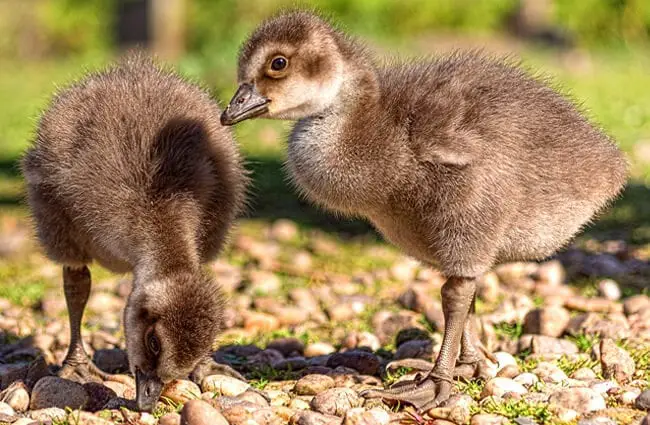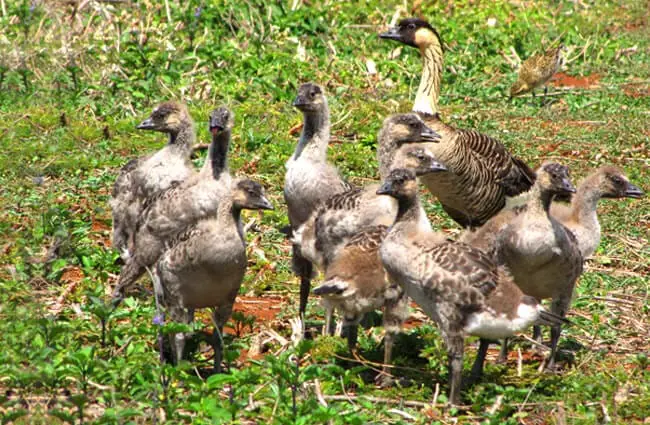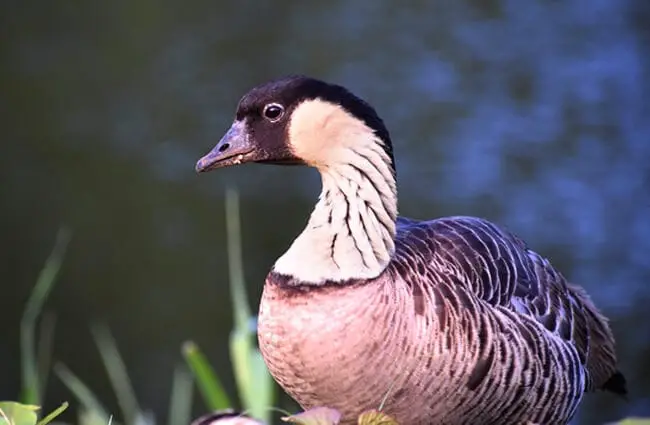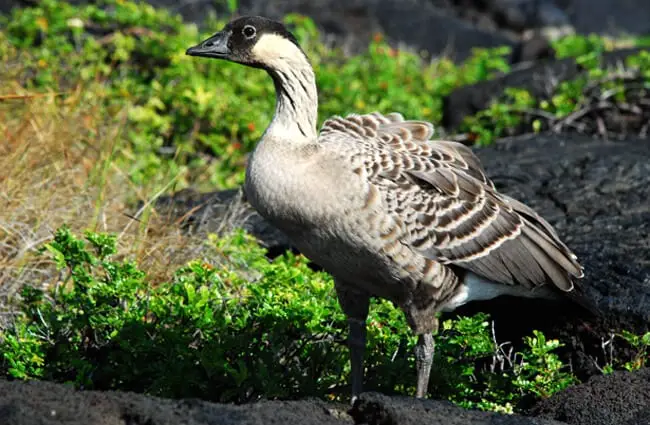The Nene: Hawaii’s Endearing Avian Ambassador
Deep within the emerald embrace of the Hawaiian Islands lives a creature of remarkable resilience and unique charm: the Nene, or Hawaiian Goose (Branta sandvicensis). This isn’t just any goose; it is a symbol of Hawaii’s extraordinary biodiversity and a testament to the power of dedicated conservation. As a zoologist who has spent years unraveling the mysteries of the natural world, the Nene’s story is one that captivates and inspires, offering a window into evolution, adaptation, and the delicate balance of island ecosystems.
Join us on a journey to discover the Nene, from its distinctive appearance and preferred habitats to its fascinating evolutionary past, intricate life cycle, and profound connection with both its environment and humanity. Whether you are a student embarking on a research project, an animal lover dreaming of a wild encounter, an aspiring zoologist, a curious hiker, or a dedicated zookeeper, this comprehensive guide will illuminate the world of Hawaii’s beloved state bird.
Meet the Nene: A Distinctive Hawaiian Goose
The Nene stands apart from its continental cousins with several key adaptations that speak volumes about its island home. Visually, it is a medium-sized goose, typically weighing between 3.5 to 6.5 pounds (1.6 to 3 kg) and standing about 25 inches (64 cm) tall. Its most striking features include a black head and neck, buff-colored cheeks, and deeply furrowed neck feathers that create a distinctive striped pattern. The body plumage is generally brown and grey, providing excellent camouflage against the volcanic landscapes it inhabits.
Perhaps the most telling adaptation for its terrestrial lifestyle on rugged lava flows and grasslands are its feet. Unlike most geese, the Nene possesses only partially webbed feet. This anatomical modification is crucial for navigating uneven, rocky terrain with greater agility, rather than spending extensive time in water. Its call is a soft, low “nay-nay,” which gives the species its evocative Hawaiian name.

Where the Nene Roams: Habitat and Distribution
The Nene is endemic to the Hawaiian Islands, meaning it is found nowhere else on Earth. Its natural habitat is remarkably diverse, reflecting the varied landscapes of Hawaii. These geese thrive in a range of environments, from the dry, shrublands and grasslands of volcanic slopes to coastal dunes and even barren lava flows. They are often found at elevations ranging from sea level up to 8,000 feet (2,400 meters).
Historically, Nene were found on all the main Hawaiian Islands. Today, their primary populations are concentrated on the islands of Hawaii, Maui, and Kauai, with smaller, reintroduced populations on Molokai. Key areas for Nene sightings include:
- Hawaii Island: Hawaii Volcanoes National Park, especially around the Kilauea caldera and Mauna Loa slopes.
- Maui: Haleakala National Park, particularly in the crater and surrounding high-elevation grasslands.
- Kauai: Coastal areas, golf courses, and protected natural reserves, often at lower elevations.
For an animal lover hoping to spot a Nene in the wild, visiting these national parks and protected areas during the early morning or late afternoon offers the best chances. Patience and a keen eye are essential, as their natural camouflage can make them blend seamlessly with their surroundings.

A Journey Through Time: Nene Evolution and Ancestry
The Nene’s evolutionary story is a captivating example of adaptive radiation, a process where a single ancestral species diversifies into many new forms to fill available ecological niches. Genetic studies indicate that the Nene descended from the Canada Goose (Branta canadensis) approximately 500,000 years ago. A small group of these geese likely migrated or were blown off course to the Hawaiian Islands, becoming isolated from their mainland relatives.
Over millennia, these pioneering geese underwent significant evolutionary changes to adapt to their new, predator-free, and largely aquatic-resource-poor environment. The most notable adaptations include:
- Reduced Webbing: As mentioned, the partial webbing on their feet is a direct adaptation to a terrestrial lifestyle on rugged volcanic terrain, where extensive swimming was less necessary.
- Stronger Legs: Their legs became longer and stronger, better suited for walking and climbing over lava flows and through dense vegetation.
- Flight Adaptation: While their ancestors were strong fliers, some extinct Hawaiian goose species became entirely flightless. The Nene, however, retained its ability to fly, albeit with a less migratory pattern than its ancestors, primarily for local movements and escaping predators.
- Dietary Shift: Adapting to the available flora of Hawaii, their diet shifted to primarily terrestrial plants, berries, and seeds.
This remarkable transformation from a migratory, water-dependent goose to a largely terrestrial, endemic island species highlights the power of natural selection in shaping life forms to their unique environments.
What Sustains the Nene: Diet and Foraging
As a primarily herbivorous species, the Nene’s diet is a direct reflection of the Hawaiian flora. These geese are opportunistic foragers, grazing on a variety of plant materials found in their diverse habitats. Their diet includes:
- Grasses: Various native and introduced grasses form a significant portion of their intake.
- Leaves: They consume the leaves of a wide range of plants and shrubs.
- Seeds: Seeds from different plant species provide essential nutrients.
- Berries: Native Hawaiian berries are a crucial food source, particularly the ‘ōhelo berry (Vaccinium reticulatum) and pūkiawe berry (Styphelia tameiameiae). These berries are not only nutritious but also play a role in seed dispersal.
Nene spend a considerable amount of time foraging, using their strong beaks to pluck vegetation. Their diet provides the necessary energy for their unique breeding cycle and daily activities, showcasing their deep connection to the plant life of the islands.

Love and Legacy: Mating and Reproduction
The Nene exhibits a fascinating reproductive strategy, distinct from most other goose species. They are generally monogamous, forming strong pair bonds that can last for life. Their breeding season is exceptionally long and unusual, typically spanning from October to April, which is outside the typical breeding season for most Northern Hemisphere geese. This extended period allows them to take advantage of the mild Hawaiian climate and consistent food availability.
Key aspects of Nene reproduction include:
- Nesting: Nene build their nests on the ground, often in secluded, well-hidden spots amidst dense vegetation, under shrubs, or in lava crevices. The female constructs the nest using plant material and lines it with down feathers plucked from her own body.
- Clutch Size: A typical clutch consists of 2 to 5 eggs, though occasionally more.
- Incubation: The female alone incubates the eggs for approximately 29 to 32 days, while the male stands guard nearby, diligently protecting the nest from potential threats.
- Goslings: Nene goslings are precocial, meaning they are born relatively mature and able to walk and feed themselves shortly after hatching. They are covered in soft down feathers and quickly learn to follow their parents.
- Parental Care: Both parents care for the goslings, leading them to foraging areas and protecting them until they fledge (develop flight feathers) at around 10 to 12 weeks of age.
The success of Nene breeding is vital for the species’ survival, and conservation efforts often focus on protecting nesting sites and ensuring the safety of goslings.

Nene in the Ecosystem: Their Role and Interactions
Despite their relatively small population size, Nene play a subtle yet important role in the Hawaiian ecosystem. As herbivores, they contribute to the grazing of vegetation, which can influence plant community structure. More significantly, through their consumption of berries, Nene act as seed dispersers. When they consume fruits like ‘ōhelo and pūkiawe, the seeds pass through their digestive system and are deposited elsewhere, often with a natural fertilizer packet, aiding in the propagation of these native plants across the landscape. This makes them an integral part of the natural regeneration process of Hawaiian forests and shrublands.
In terms of interactions with other animals, the Nene historically faced few natural predators in Hawaii prior to human arrival. The main threats to goslings and eggs would have come from native raptors like the Hawaiian Hawk (Buteo solitarius) or perhaps opportunistic native birds. However, with the introduction of invasive species by humans, the Nene now faces significant predation pressure from animals such as mongooses, feral cats, and dogs, which prey on eggs, goslings, and even adult birds. This shift in predator dynamics has profoundly impacted Nene populations and underscores the challenges of island conservation.
Nene and Humanity: Cultural Significance and Conservation
The Nene holds a special place in the hearts of Hawaiians and is recognized globally as a symbol of successful conservation. It was designated the State Bird of Hawaii in 1957, a testament to its unique status and cultural importance. For centuries, the Nene has been a part of Hawaiian folklore and natural heritage, representing the spirit of the islands.
However, the Nene’s journey has been fraught with peril. By the mid-20th century, the species was teetering on the brink of extinction, with fewer than 30 individuals remaining in the wild. This drastic decline was primarily due to:
- Habitat Loss: Conversion of native lands for agriculture and development.
- Introduced Predators: Non-native mammals like mongooses, cats, and dogs, which preyed on eggs, goslings, and adults.
- Hunting: Historical hunting pressure.
A monumental conservation effort, involving captive breeding programs, habitat restoration, and predator control, began in the 1950s. Nene were bred in zoos and conservation centers, then carefully reintroduced into protected areas. This concerted effort has been remarkably successful, bringing the Nene back from the brink. While still considered a vulnerable species, its population has rebounded significantly, demonstrating what can be achieved with dedicated conservation action. This story serves as a powerful reminder of humanity’s impact, both destructive and restorative, on the natural world.

Encountering the Nene: Etiquette for Wildlife Observers and Hikers
For anyone fortunate enough to encounter a Nene in the wild, it is a truly special experience. To ensure the safety and well-being of these precious birds, especially considering their vulnerable status, it is crucial to observe proper wildlife etiquette:
- Maintain Distance: Always keep a respectful distance from Nene. The general recommendation is at least 20 feet (6 meters). This is particularly important during breeding season (October to April) when Nene may be nesting or have goslings. Disturbing them can cause stress and lead to nest abandonment or separation of parents from their young.
- Never Feed Them: Feeding wild animals, including Nene, can be detrimental to their health and behavior. It can make them dependent on humans, lose their natural foraging instincts, and become more susceptible to predators or vehicle collisions. Human food is also often unhealthy for them.
- Observe Quietly: Enjoy their presence without making loud noises or sudden movements that could startle them.
- Respect Nesting Sites: If you happen upon a Nene nest, do not approach it. Give it a wide berth and avoid lingering. Nests are often well-camouflaged and can be difficult to spot, so always be vigilant, especially when hiking off marked trails.
- Drive Carefully: In areas where Nene are known to frequent, especially near roads, drive slowly and be alert for birds on or near the pavement. Nene are often hit by vehicles.
- Report Injured Birds: If you see an injured Nene or a Nene in distress, contact local park rangers or wildlife authorities immediately.
By following these guidelines, hikers and animal lovers can contribute to the ongoing protection of the Nene and ensure future generations can also marvel at these unique geese.
Caring for Nene: Insights for Zookeepers and Conservationists
For zookeepers and conservationists involved in Nene care, whether in captive breeding programs or rehabilitation efforts, a specialized approach is required to mimic their natural environment and promote their well-being. Key tasks and considerations include:
- Dietary Management: In captivity, Nene are typically fed a balanced diet of commercial waterfowl pellets, supplemented with fresh greens, grasses, and native Hawaiian berries when available. It is crucial to monitor their intake to prevent obesity and ensure they receive all necessary nutrients.
- Enclosure Design: Enclosures must be spacious, secure, and designed to replicate their natural habitat as much as possible. This includes providing varied terrain, areas for grazing, and sheltered nesting sites. Predator-proofing is paramount to protect against introduced species.
- Health Monitoring: Regular veterinary check-ups, parasite control, and prompt treatment of any illnesses are essential. Zookeepers must be vigilant for signs of stress or disease.
- Breeding Programs: For captive breeding, careful genetic management is necessary to maintain genetic diversity within the population. Providing optimal nesting conditions, monitoring egg laying, and ensuring safe incubation are critical for successful reproduction.
- Enrichment: Environmental enrichment, such as varied foraging opportunities, different substrates, and naturalistic features, helps to stimulate natural behaviors and prevent boredom.
- Predator Avoidance Training: For birds destined for release into the wild, some programs incorporate training to help them recognize and avoid common predators, enhancing their survival chances post-release.
What to avoid in Nene care:
- Overcrowding: Can lead to stress, aggression, and increased disease transmission.
- Inappropriate Diet: Feeding human foods or an unbalanced diet can cause nutritional deficiencies or health problems.
- Lack of Security: Inadequate predator control can lead to devastating losses.
- Excessive Human Interaction: While care is necessary, minimizing direct human contact helps maintain their natural wariness, which is important for wild release candidates.
The dedication of zookeepers and conservationists is a cornerstone of the Nene’s recovery story, ensuring a healthy population both in and out of their native habitat.
A Huge List of Interesting Nene Facts
The Nene is full of surprises! Here is a collection of fascinating facts that highlight its unique nature:
- State Bird: The Nene was officially designated the State Bird of Hawaii in 1957.
- Partially Webbed Feet: Unlike most geese, Nene have only partially webbed feet, an adaptation for walking on rough, volcanic terrain rather than extensive swimming.
- Terrestrial Lifestyle: They are the most terrestrial of all goose species, spending most of their time on land.
- Unique Call: Their soft, low “nay-nay” call is the origin of their Hawaiian name.
- Longest Breeding Season: The Nene has the longest breeding season of any goose, typically from October to April.
- Critically Endangered: In the mid-20th century, the Nene population plummeted to fewer than 30 individuals, making it one of the rarest birds in the world.
- Conservation Success: Thanks to intensive captive breeding and reintroduction programs, its population has significantly recovered, making it a celebrated conservation success story.
- Canadian Ancestry: Genetic evidence suggests the Nene evolved from the Canada Goose, which likely arrived in Hawaii hundreds of thousands of years ago.
- Seed Dispersers: By eating native berries, Nene help disperse seeds, contributing to the health and regeneration of Hawaiian plant communities.
- Monogamous: Nene typically form strong, monogamous pair bonds that can last for life.
- Ground Nesters: They build their nests on the ground, often in secluded spots hidden by vegetation or lava crevices.
- Precocial Young: Nene goslings are precocial, meaning they are relatively independent shortly after hatching.
- High Elevation Dwellers: While found at sea level, Nene can also thrive at elevations up to 8,000 feet (2,400 meters) on volcanic slopes.
- Vulnerable Status: Despite recovery, the Nene is still classified as a vulnerable species, facing ongoing threats from introduced predators and habitat loss.
- Protected Species: It is illegal to harm or harass a Nene, and they are protected under both state and federal laws.
Conclusion: A Beacon of Hope for Island Biodiversity
The Nene’s story is more than just the tale of a unique goose; it is a powerful narrative about the interconnectedness of life, the fragility of island ecosystems, and the profound impact of human actions. From its evolutionary journey from a continental ancestor to its specialized adaptations for Hawaiian landscapes, the Nene embodies the spirit of resilience. Its role in seed dispersal, its distinctive reproductive cycle, and its cultural significance all paint a picture of a species deeply woven into the fabric of Hawaii.
The remarkable recovery of the Nene from the brink of extinction stands as a beacon of hope, demonstrating that with scientific understanding, dedicated effort, and community engagement, even the most imperiled species can be given a second chance. As we continue to learn from and protect these magnificent birds, we not only safeguard a unique piece of Hawaii’s natural heritage but also gain invaluable insights into the broader challenges and triumphs of global biodiversity conservation. The Nene reminds us that every species has a story worth telling, and a future worth fighting for.

![Red Angus Closeup of a beautiful Red Angus cowPhoto by: U.S. Department of Agriculture [pubic domain]https://creativecommons.org/licenses/by/2.0/](https://animals.net/wp-content/uploads/2020/03/Red-Angus-4-238x178.jpg)




![Red Angus Closeup of a beautiful Red Angus cowPhoto by: U.S. Department of Agriculture [pubic domain]https://creativecommons.org/licenses/by/2.0/](https://animals.net/wp-content/uploads/2020/03/Red-Angus-4-100x75.jpg)

